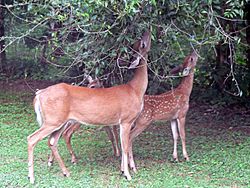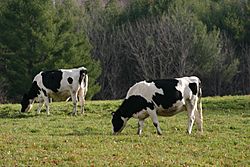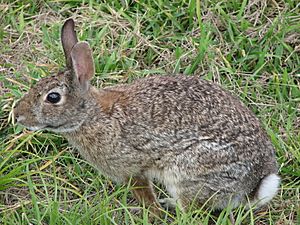Herbivore facts for kids
Herbivores are animals that only eat plants. They are herbivorous animals.
Herbivores (such as deer, elephants, horses) have teeth that are adapted to grind vegetable tissue. Many animals that eat fruit and leaves sometimes eat other parts of plants, for example roots and seeds. Usually, such animals cannot digest meat. But some herbivorous animals will eat eggs and occasionally other animal protein.
Some animals are frugivores because they eat mainly fruit. Browsers eat mostly leaves and sometimes small tree branches. Animals that eat mostly grass are grazing animals.
The diets of some herbivorous animals change with the seasons. In the temperate zones of the Earth, some seasons are hot and some are cold, so different plants are available at different times of the year.
Humans are omnivores, because they eat meat as well as vegetable matter. People who eat mostly plants are usually called vegetarian or vegan.
Contents
Digesting cellulose
Plant cell walls are mostly made up of cellulose. No animal can digest cellulose by itself. They make use of gut flora, some of which produce an enzyme called cellulase. This is an example of symbiosis.
Herbivore-plant interactions
According to the theory of predator-prey interactions, the relationship between herbivores and plants is cyclic. When prey (plants) are numerous their predators (herbivores) increase in numbers, reducing the plant population, which in turn causes herbivore number to decline. The prey population eventually recovers, starting a new cycle. This suggests that the population of the herbivore fluctuates around the carrying capacity of the food source, in this case the plant.
There will always be pockets of plants not found by herbivores. This is important for specialist herbivores which feed on only one species of plant: it prevents these specialists from wiping out their food source. Eating a second plant type helps herbivores’ populations stabilize. Alternating between two or more plant types provides population stability for the herbivore, while the populations of the plants oscillate. When an invasive herbivore or plant enters the system, the balance is thrown off and the diversity can change or even collapse.
In some ways it is easier to be an herbivorous animal than a carnivorous (meat-eating) animal. Carnivorous animals have to find and catch the animals that they eat, and sometimes the animals that they want to eat fight them. Herbivorous animals have to find the plants that they want to eat, but they do not have to catch them. Many plants have some defence against herbivores, such as spines, toxins (poisons), or a bad taste. There are many more herbivorous animals living in the world than carnivorous animals.
Feeding strategies
Two herbivore feeding strategies are grazing (e.g. cows) and browsing (e.g. moose). A grazer needs to have at least 90% of the forage as grass, and for a browser at least 90% tree leaves and/or twigs. "Selective" means that herbivores may choose their forage source depending on, e.g., season or food availability, but also that they may choose high quality (and consequently highly nutritious) forage before lower quality.
Herbivores employ numerous types of feeding strategies. Many herbivores do not fall into one specific feeding strategy, but employ several strategies and eat a variety of plant parts.
| Feeding Strategy | Diet | Example |
|---|---|---|
| Algivores | Algae | krill, crabs, sea snail, sea urchin, parrotfish, surgeonfish, flamingo |
| Frugivores | Fruit | Ruffed lemurs |
| Folivores | Leaves | Koalas |
| Nectarivores | Nectar | Honey possum |
| Granivores | Seeds | Hawaiian honeycreepers |
| Palynivores | Pollen | Bees |
| Mucivores | Plant fluids, i.e. sap | Aphids |
| Xylophages | Wood | Termites |
Some examples of herbivores
Related pages
Images for kids
-
A sawfly larva feeding on a leaf
-
A fossil Viburnum lesquereuxii leaf with evidence of insect herbivory; Dakota Sandstone (Cretaceous) of Ellsworth County, Kansas. Scale bar is 10 mm.
-
Leaf miners feed on leaf tissue between the epidermal layers, leaving visible trails
-
Mixed feeding shoal of herbivorous fish on a coral reef
See also
 In Spanish: Herbívoro para niños
In Spanish: Herbívoro para niños










